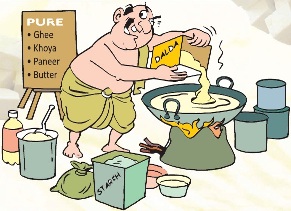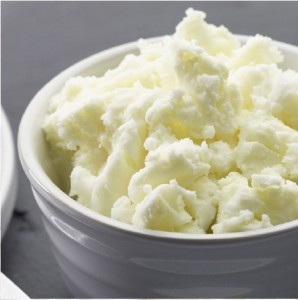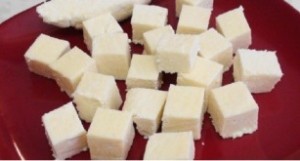June 18: COVER STORY
- Posted by CERC India
- Posted in JUNE
Are loose dairy products safe?
40 samples of loose ghee, khoya, paneer and butter tested from 22 dairies at 19 locations. Find out our alarming findings
From hot phulkas gently smeared with ghee to delicious gajar halwa with khoya and finger-licking good paneer tikka. Not to forget – warm buttered toast! Whether you are a foodie or not, visions of these foods are sure to get you salivating. Dairy products are so much an integral part of Indian cuisine that we cannot think of doing without them.
However, pilot tests, complaints from consumers and media reports have indicated that loose, unbranded samples of ghee, khoya, paneer and butter are susceptible to adulteration and contamination. Our concern for the health of consumers impelled us to test these products for purity and quality.
We tested ghee, khoya and paneer to check for adulteration and contamination. Butter was tested for microbiological contamination. In this issue, Grahak Sathi brings to you a Dairy Special in which we carry test reports on loose ghee, khoya, paneer and butter.Â
Nutshell
- Neither is price an indicator, nor the reputation of a dairy a guarantee, of good quality.
- Wherever available go for a packaged branded dairy product as loose products are prone to adulteration and contamination.
- Our tests found 50% of ghee and 60% of khoya samples to be adulterated. Also, 40% of ghee and 70% of khoya samples were of poor quality. Paneer samples were free from adulteration but 70% were of poor quality.
- Test findings indicate that 60% of loose white butter samples had coliform count and 80% had yeast and mould count well above permissible limits.
- Both adulteration and microbiological contamination have serious health implications.
- The average price of branded paneer and butter was more than the average price of the loose products. But it must be noted that it is loose products that are prone to adulteration and contamination. It is not worth endangering your health for a few rupees.
Ghee, khoya and paneer
We tested loose samples of ghee, khoya and paneer procured from various localities in and around Ahmedabad city. The samples were tested for adulteration and contamination as per a set of two instruction manuals developed by the Food Safety and Standards Authority of India (FSSAI).
Parameters testedÂ
- Colour (appearance)
- Odour (whether free from musty, rancid odour)
- Foreign matter (physical parameter)
- Rancid or old ghee
- Presence of following adulterants:
- vanaspati
- mashed potato or sweet potato (ghee)
- synthetic colouring matter (ghee)
- coal tar dyes
- blotting paper (khoya)
- starch (khoya, paneer)
Significance of parameters
Adulteration: Adulteration with vanaspati and/or starch is a grave concern with adverse health impact. It also means the consumer has been cheated at the cost of the manufacturer/trader’s economic gain. Food adulteration is an act of intentionally debasing the quality of food offered for sale either by the admixture (addition of an ingredient), substitution with inferior substances or by the removal of some valuable ingredient.
Unpleasant odour and poor colour: Foul odour in freshly drawn samples is a serious concern. This along with ‘off’ colour raises serious concern about the freshness of the products. Poor appearance and odour indicate that the samples had been exposed to air or unclean surroundings at the production plant or dairy for a prolonged period.
Presence of foreign matter: This implies improper storage facilities in the dairy or provision store. Sometimes burnt milk may also result in occurrence of black particles in dairy products.
Rancidity: Rancidity indicates that either the sample belonged to an old lot and/or had been mixed with old stock. Rancid samples have a strong disagreeable flavor and odour which render them unfit for consumption.
Ghee key findingsÂ
- Five out of ten samples (50%) were found to be adulterated with vanaspati or vegetable fat.
- Also, around 40% of the samples were of poor quality. The reasons:
- Two samples were found to be offensive in odour and one was found to be sour smelling.
- One sample was found to be rancid.
- Six samples out of ten were found to contain foreign matter on visual inspection. While four had black particles, two had brown particles.
- All ten samples tested were found to be free from adulteration with mashed potato or sweet potato, synthetic colouring matter or coal tar dyes.
- Six samples tested were found to be of pale yellow colour while the rest were off-white.
Khoya key findings
- Five out of ten samples were adulterated with vanaspati. Two samples showed adulteration with starch.
- Also, 70% of the samples were of poor quality. The reasons:
- Four samples were found to be sour smelling. One sample was curdy in smell.
- Two samples were rancid.
- All the samples showed presence of foreign matter in them. Four samples had brown particles, four had black particles while two out of them had green fungal growth as well. One sample showed presence of small, black insect parts and one had fungus.
- As far as appearance is concerned, one sample showed brownish discoloration.
- The worst-performing sample was from Kalupur area which was the cheapest and was found to be adulterated with starch as well as vanaspati.
- None of the samples tested showed presence of blotting paper or coal tar dyes.
- Three samples were off-white (pale in colour), six were creamish while one was brownish in colour.
Paneer key findingsÂ
- The good news is that all the samples tested were free from adulteration with starch, vanaspati or coal tar dyes.
- However, 70% of the samples tested were found to be of poor quality. The reasons:
- Two samples had a musty odour while four samples were sour smelling.
- One sample had an offensive rancid smell.
- Four samples showed the presence of black particles.
- Only three samples were white in colour. The rest were off-white (pale coloured).

Observations (See table on Test Results: Ghee, Khoya and Paneer):
- There is no consistency among dairies across products. So, consumers cannot go by the reputation of a dairy. For instance, in Ambika Dairy and Laxmi Dudh Ghar, the paneer was good but ghee was adulterated with vanaspati and of poor quality.
- Overall performance of Gokul Dairy, Sri Krishna Dudh Ghar and Patel Mawawala were found to be poor.
- Price is not an indicator of quality.
- The cheapest khoya was sold by Patel Mawawala and was found to be adulterated with both starch and vanaspati and of poor quality. However, even the costliest Radhe Dairy khoya was found to be of poor quality.
- In the case of ghee, the costliest products from Ghanshyam Dairy and Vipul Dudhiya were found to be good. However, two other highly priced ones (Sri Krishna Dudh Ghar and Laxmi Dudh Ghar) were found to be adulterated with vanaspati and of poor quality.
- The worst quality products were sold in Kalupur, Shahibaug and Isanpur.
Expert opinion                                                                                                                          Â
We spoke to Dr. H.G. Koshia, commissioner of the Gujarat Food and Drug Control Administration (FDCA) on the issue of adulteration. Excerpts:Â Â
Q. In the last one year, how many samples did you find adulterated in these four categories of products?
A. A total of 86 samples were declared substandard in 2017 under the category of ghee, khoya, paneer and butter.
Q. What were the major type of adulterants found product-wise?
A. The majority of samples failed to meet the standards set by the FSSAI. In a few samples, the presence of vegetable fats were found as an adulterant.
Q. What are the penalties by law for adulteration?
A. The penalty for substandard food is a fine up to Rs. 5 lakh.
Q. What can consumers do?
A. Consumers can directly take the samples and send them for analysis to NABL accredited laboratories. List of NABL accredited labs is available at Central Drugs Standard Control Organization website www.cdsco.nic.in. They can complain on the toll-free number 1800-233-5500. Economic frauds like adulteration will be curbed if consumers remain vigilant.
 Butter key findings
 We tested butter samples for two microbiological parameters – Coliform count and Total Yeast and Mould count. According to the Bureau of India Standards (BIS), the limit for Coliform count is 5/ml while the limit for Total Yeast and Mould count is 20/ml.
- Six samples had Coliform count much above the permissible limit. The alarmingly high levels in the six samples ranged from 46/ml to 240/ml.
- Eight samples had Total Yeast and Mould count much above the permissible limit. The high levels in the eight samples ranged from 23/ml to 2100/ml.
Significance of parameters
Coliforms: The presence of these microorganisms indicates possible faecal contamination. Coliform bacteria can cause bloody diarrhoea, vomiting, gastroenteritis, urinary tract infections and typhoid.
Yeast and mould: These fungi are major food spoilage agents. They turn food rancid, cause unwanted fermentation or leave a musty taste. Butter gets discoloured due to surface growth of moulds and develops an ‘off’ flavour. Some moulds produce mycotoxins that can pose serious health risks to humans. Other problems include allergic reactions and respiratory problems. 
Observations (See table on Test Results of Butter):
- The results suggest that loose butter is produced under unhygienic conditions. The counts of microorganisms above the limits and the presence of pathogenic bacteria pose a risk to public health.
- Price is not an indicator of quality. Among the two highest priced products, one was free of both coliform and yeast and mould (Om Purvam Dairy) while the other had high levels of coliform and yeast and mould counts (Gokul Dairy).
- Three products that were priced low between Rs. 20 and Rs. 25 for 100g had both coliform and yeast and mould counts well above the limits.
Dairy products – Price comparisonÂ
We made a price comparison between the branded and loose dairy product for ghee, butter and paneer. (See table below) Branded khoya is not available in the market. Interestingly, in the case of ghee, the loose product is more expensive. In the case of butter and paneer this was not the case. But it must be noted that it is loose products that are prone to adulteration. It is not worth endangering your health for a few rupees.
 Purchase tips
Purchase tips
Colour: The colour of ghee can range from white/off-white to pale yellow depending on the variety, origin and processing. In the case of khoya and paneer, avoid, pale yellow coloured product or one having a greenish tinge. As for butter, cut a small slice from the block. If the inside of the butter is the same colour as the outside it is fresh. However, if the inside is a lighter colour than the outside it means the butter has oxidized and is no longer fresh.
Odour, texture and taste: Fresh ghee has a pleasant odour and is semi-liquid at room temperature. Fresh khoya is usually soft and firm while stale khoya is hard and brittle in texture. Fresh paneer is usually soft and spongy in feel while a stale product is hard and rubbery in texture. In the case of butter, the taste indicates the quality. If the butter tastes sour, it should not be consumed.
How to store dairy productsÂ
Ghee can be stored at room temperature in a cool and dry place. While khoya should be stored in refrigerator, paneer needs be stored in the deep freezer. Butter should be refrigerated in its original wrapper. This prevents spoilage due to exposure to light and air and also protects it from picking up the flavour of other foods. Both salted and unsalted butter preserved this way last for three weeks.Â
Areas of action
The regulatory bodies and the enforcement agencies need to take up the matter of adulteration urgently in order to avoid health scares and also economic loss of consumers. CERC will be sending a representation to the authorities urging them to:
- Ensure that regulations that prevent adulteration in dairy products are implemented
- Test and monitor food products that are sold loose regularly
- Raise consumer awareness about adulteration and food safety
- Ensure that local butter manufacturers adopt safe and hygienic practices during production and storage
- See that consumers are educated on how to handle dairy products including correct storage to prevent deterioration of products
Grahak Sathi’s conclusionÂ
Neither is price an indicator, nor the reputation of a dairy a guarantee, of good quality. Dairies do not perform consistently across products. Also, the most expensive product need not be the best. So, how is the consumer to make his or her choice?
Wherever available go for a packaged branded dairy product as loose products are prone to adulteration and contamination. If you are buying a loose product, before choosing a dairy or store, ensure it has proper storage and refrigeration facilities. First buy a small quantity and check the quality before you go in from a larger purchase from that outlet. Consumer awareness is vital to eliminate the evil of adulteration and sale of substandard food products.








